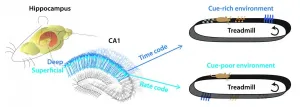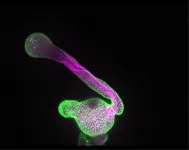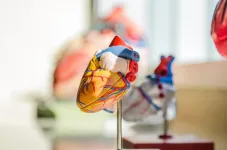Peeking at the pathfinding strategies of the hippocampus in the brain
Observed the pattern of change in place cells in animal experiments using cue-poor and cue-rich spatial environments. Suggesting new directions in the treatment of brain disorders like Alzheimer's and amnesia, and advancement in the AI
2021-02-15
(Press-News.org) We find routes to destination and remember special places because there is an area somewhere in the brain that functions like a GPS and navigation system. When taking a new path for the first time, we pay attention to the landmarks along the way. Owing to such navigation system, it becomes easier to find destinations along the path after having already used the path. Over the years, scientists have learned, based on a variety of animal experiments, that cells in the brain region called hippocampus are responsible for spatial perception and are activated in discrete positions of the environment, which which reason they are called "place cells". However, how place cells store long-term memories of locations and encode particular positions in the environment is still not understood.
The Korea Institute of Science and Technology (KIST) announced that the research team led by Sebastien Royer at KIST Brain Science Institute (BSI), in collaboration with a research team at New York University (NYU), uncovered that place cells in the hippocampus encode spatial information using interchangeably two distinct information processing mechanisms referred to as a rate code and a phase code, somewhat analogue to the number and spatial arrangement of bars in bar codes. In addition, the research team found that parallel neural circuits and information processing mechanisms are used depending on the complexity of the landmarks along the path.
The KIST and NYU research teams identified fundamental principles of information processing in the hippocampus by conducting two types of spatial exploration experiments. In the first type of experiment, the researchers used a treadmill with a long belt, a well controlled spatial environment for mice, and trained the animals to run on the belt sequentially through a section cleared of any objects and another section furnished with small objects. The second type of experiment was carried with rats foraging in a circular arena that was either completely empty or filled with objects. To analyze neural activity, they implanted silicon probe electrodes in CA1, the subregion generating the main output of the hippocampus, and in CA3, a subregion of the hippocampus suspected of playing an important role in spatial memory formation.
Results of the two experiments were consistent. It was found that the hippocampus uses different neural circuits and information processing strategies depending on the environmental conditions. In the object-free environments, a group of cells located in the superficial region of CA1 tends to be active and uses a rate code since the animal position is best predicted by changes in the frequency of action potentials discharged by single neurons. In contrast, in a complex, object-strewn environment, a group of cells in the deep region of CA1 tend to be active and uses a phase code since the animal position is best predicted by the timing of a neuron action potentials relative to the ensemble of active neurons.
These findings suggest that the circuit using the rate code is more strongly associated with providing information about overall positioning and spatial perception, whereas the circuit using the phase code is more strongly associated with remembering the precise location of an object and spatial relationships. Aside from this, the respective contribution of inputs from CA3 and the entorhinal cortex was also analysed. It is known that CA1 receive information from both the CA3 region and the entorhinal cortex. In this study, based on differences in fast network oscillations called "gamma", it was found that superficial CA1 cells receive information primarily from CA3 in the simple environments whereas deep CA1 cells receive information primarily from the entorhinal cortex in the complex environments.
Sebastien Royer, Principal investigator at KIST said "this study improves our understanding on how the hippocampus processes information, which is a critical step for understanding the general mechanisms of memory." He added that "such basic level understanding will eventually help the development of technologies for the diagnosis and treatment of brain disorders related to hippocampal injury such as Alzheimer's type dementia, amnesia, and cognitive impairment, and might inspire the development of some AI."
The research team headed by Sebastien Royer, PhD has been gradually expanding the understanding of information storage and processing in memory-related brain areas using diverse approaches. In a study combining mouse experiment and neural network modeling published last year in the journal "Nature Communications", the same team identified the process by which granule cells in the dentate gyrus region of the hippocampus develop a uniform mapping of the space during spatial learning.
INFORMATION:
The study was conducted as a KIST major project and funded by the Ministry of Science and ICT (MSIT). The study findings were published in the latest issue of the international academic journal, "Neuron."
[Attachments] See images for this press release:

ELSE PRESS RELEASES FROM THIS DATE:
2021-02-15
Lipids are the building blocks of a cell's envelope - the cell membrane. In addition to their structural function, some lipids also play a regulatory role and decisively influence cell growth. This has been investigated in a new study by scientists at Martin Luther University Halle-Wittenberg (MLU). The impact of the lipids depends on how they are distributed over the plasma membrane. The study was published in "The Plant Cell".
If plant cells want to move, they need to grow. One notable example of this is the pollen tube. When pollen lands on a flower, the pollen tube grows directionally into the female reproductive organs. This allows the male gametes to be delivered, so fertilisation can occur. The pollen tube is special ...
2021-02-15
An international team of scientists has sequenced the genome of a capuchin monkey for the first time, uncovering new genetic clues about the evolution of their long lifespan and large brains.
Published in PNAS, the work was led by the University of Calgary in Canada and involved researchers at the University of Liverpool.
"Capuchins have the largest relative brain size of any monkey and can live past the age of 50, despite their small size, but their genetic underpinnings had remained unexplored until now," explains Professor Joao Pedro De Magalhaes, who researches ageing at the University of Liverpool.
The researchers developed and annotated a reference assembly for white-faced ...
2021-02-14
Aspirin should be favoured over warfarin to prevent blood clotting in children who undergo a surgery that replumbs their hearts, according to a new study.
The research, led by the Murdoch Children's Research Institute (MCRI) and published in The Journal of Thoracic and Cardiovascular Surgery, will have implications for clinicians when prescribing blood thinning medications after Fontan surgery, a complex congenital heart disease operation redirecting blood flow from the lower body to the lungs.
The Fontan procedure is offered to children born with severe heart defects, allowing the child to live with just one pumping heart chamber ...
2021-02-13
In a SWOG Cancer Research Network trial that put three targeted drugs to the test, the small molecule inhibitor cabozantinib was found most effective in treating patients with metastatic papillary kidney cancer - findings expected to change medical practice.
These findings will be presented at ASCO's virtual 2021 Genitourinary Cancers Symposium on Feb. 13, 2021 at 1 p.m. ET. The findings will be simultaneously published in The Lancet.
There are currently no effective treatments for metastatic papillary kidney cancer, or metastatic pRCC, a rare subtype of kidney cancer. One study of 38 patients found that the average survival ...
2021-02-13
Lenvatinib plus pembrolizumab yields better overall survival than single-agent sunitinib when given as first-line therapy in untreated patients with metastatic kidney cancer
The combination also improved progression-free survival and overall response rate
BOSTON - Patients with advanced kidney cancer, who received a targeted drug combined with a checkpoint-blocker immunotherapy agent had longer survival than patients treated with the standard targeted drug, said an investigator from Dana-Farber Cancer Institute, reporting results from a phase 3 clinical trial.
The survival benefit demonstrates that an immune checkpoint inhibitor together with a targeted kinase inhibitor drug "is important ...
2021-02-13
A test that monitors blood levels of DNA fragments released by dying tumor cells may serve as an accurate early indicator of treatment success in people in late stages of one of the most aggressive forms of skin cancer, a new study finds.
Led by NYU Grossman School of Medicine and Perlmutter Cancer Center researchers, the investigation looked at adults with undetectable levels of freely circulating tumor DNA (ctDNA) four weeks into drug treatment for metastatic melanoma tumors that cannot be removed surgically (unresectable). The study showed that these patients, all of whom had common genetic changes (BRAFV600 mutations) linked to cancer, were living ...
2021-02-13
Peer-reviewed / Review, Survey and Opinion piece
To ensure an effective global immunisation strategy against COVID-19, vaccines need to be produced at scale, priced affordably, and allocated globally so that they are available where needed, and successfully rolled out.
Review of evidence includes a comparison of 26 leading vaccines on their potential contribution to achieving global vaccine immunity, and a new survey of COVID-19 vaccine confidence in 32 countries.
Having new COVID-19 vaccines will mean little if people around the world are unable to get vaccinated in a timely manner. ...
2021-02-12
A new study from Washington University School of Medicine in St. Louis demonstrates that a liquid biopsy examining blood or urine can help gauge the effectiveness of therapy for colorectal cancer that has just begun to spread beyond the original tumor. Such a biopsy can detect lingering disease and could serve as a guide for deciding whether a patient should undergo further treatments due to some tumor cells evading an initial attempt to eradicate the cancer.
The study appears online Feb. 12 in the Journal of Clinical Oncology Precision Oncology, a journal of the American Society of Clinical Oncology.
While a few liquid biopsies have been approved ...
2021-02-12
FOR IMMEDIATE RELEASE
Scientists have yet to answer the age-old question of whether or how sound shapes the minds of fetuses in the womb, and expectant mothers often wonder about the benefits of such activities as playing music during pregnancy. Now, in experiments in newborn mice, scientists at Johns Hopkins report that sounds appear to change "wiring" patterns in areas of the brain that process sound earlier than scientists assumed and even before the ear canal opens.
The current experiments involve newborn mice, which have ear canals that open 11 days after birth. In human fetuses, the ear canal opens prenatally, at about 20 weeks gestation.
The findings, published online Feb. 12 in END ...
2021-02-12
A more aggressive approach to treating acne that marries the disciplines of psychology and dermatology is needed, according to two UC Riverside psychology researchers.
They also assert that women and people with darker skin disproportionately suffer from acne's psychological impacts.
"Acne is pervasive, physically harmless, and painless, so we all-too-often underestimate its impacts as the quintessential nuisance of adolescence and puberty," said UCR psychology professor Misaki Natsuaki, who authored the paper along with Tuppett Yates, also a UCR psychology professor.
The insinuation, including by developmental scientists, can be that hurtful monikers such as "pizza face" and "crater face" are best shrugged off.
But psychological ...
LAST 30 PRESS RELEASES:
[Press-News.org] Peeking at the pathfinding strategies of the hippocampus in the brain
Observed the pattern of change in place cells in animal experiments using cue-poor and cue-rich spatial environments. Suggesting new directions in the treatment of brain disorders like Alzheimer's and amnesia, and advancement in the AI




